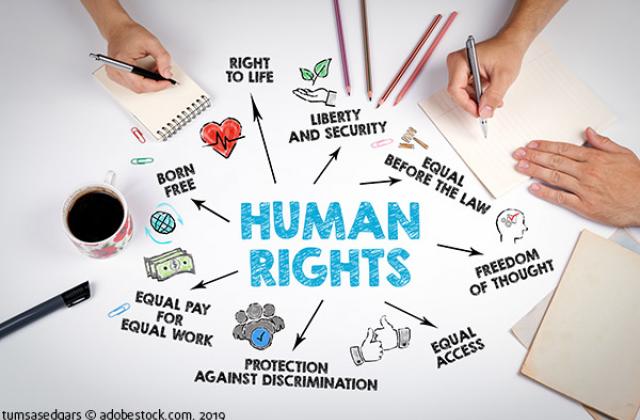Human rights law plays an essential role in protecting the dignity, freedom, and equality of all people. These laws are built upon the belief that every individual, regardless of their background, ethnicity, gender, nationality, or religion, is entitled to certain fundamental freedoms. The recognition and enforcement of human rights have become crucial not just within national borders but across the globe, forming the bedrock of international law. This article provides a comprehensive exploration of human rights law, its origins, major conventions and treaties, the role of international bodies, and the challenges it faces today.
1. What Are Human Rights?
Human rights are the basic rights and freedoms that belong to every person, regardless of where they are from, what they believe, or how they live their life. These rights are inherent to all human beings, meaning they are not given by governments but are universally recognized as necessary for human dignity.
1.1 Categories of Human Rights
Human rights can be divided into several categories, but they generally include:
- Civil and Political Rights: These rights protect individuals’ political freedoms and civil liberties, including freedom of speech, freedom of assembly, the right to vote, the right to a fair trial, and the right to privacy. They ensure that individuals can participate fully in their country’s political and social life.
- Economic, Social, and Cultural Rights: These rights ensure that every person has access to essential services and living standards, including the right to work, the right to education, the right to adequate healthcare, and the right to an adequate standard of living.
- Collective Rights: These are rights that individuals can hold collectively, such as the right to self-determination for people within a specific territory or the right to protect the environment for future generations.
Human rights encompass everything from the right to life and liberty to the right to education, employment, and healthcare.
2. The Origins of Human Rights Law
Human rights law as we know it today has evolved over centuries, shaped by historical events, revolutions, and the tireless work of human rights advocates. The key moments in the history of human rights law include:
2.1 The Universal Declaration of Human Rights (UDHR)
The modern framework for human rights law began after the Second World War, following the widespread atrocities committed during the Holocaust and other acts of violence. In 1948, the United Nations General Assembly adopted the Universal Declaration of Human Rights (UDHR), which was a milestone in international human rights law. Although it was not legally binding, the UDHR established a universal standard for human rights protection and laid the foundation for future treaties and conventions.
The UDHR outlines 30 articles, each representing different aspects of human rights, including civil, political, economic, and social rights. It has since inspired numerous national constitutions and international human rights treaties.
2.2 The Nuremberg Trials and International Justice
Following World War II, the Nuremberg Trials (1945–1949) held Nazi war criminals accountable for atrocities committed during the Holocaust. These trials established the principle of international criminal law and the idea that individuals could be held criminally responsible for violating human rights, even if their actions were ordered by a government. This marked a turning point in international justice, leading to the eventual creation of permanent institutions to prosecute crimes against humanity, war crimes, and genocide.
2.3 Development of International Human Rights Treaties
Since the adoption of the UDHR, a series of international treaties have been developed to codify human rights law. Some of the key legal instruments include:
- International Covenant on Civil and Political Rights (ICCPR): Adopted in 1966, this treaty ensures the protection of civil and political rights, such as the right to life, freedom of speech, and the right to a fair trial.
- International Covenant on Economic, Social, and Cultural Rights (ICESCR): Also adopted in 1966, this covenant focuses on economic and social rights, including the right to education, healthcare, work, and an adequate standard of living.
- Convention on the Elimination of All Forms of Racial Discrimination (CERD): Adopted in 1965, CERD aims to eliminate racial discrimination and promote equality.
- Convention on the Elimination of All Forms of Discrimination Against Women (CEDAW): Adopted in 1979, this treaty addresses gender discrimination and outlines the rights of women in areas such as education, employment, and marriage.
- Convention Against Torture (CAT): This convention, adopted in 1984, aims to prevent torture and other cruel, inhuman, or degrading treatment or punishment.
- Convention on the Rights of the Child (CRC): Adopted in 1989, the CRC establishes the rights of children to protection, education, healthcare, and participation in society.
2.4 The Role of International Bodies
Numerous international organizations and bodies are responsible for the enforcement and monitoring of human rights laws. Some of the most prominent ones include:
- The United Nations (UN): The UN, particularly through its Human Rights Council and Office of the High Commissioner for Human Rights (OHCHR), works to promote and protect human rights worldwide. It monitors human rights violations, advocates for the implementation of international human rights standards, and provides assistance to governments in fulfilling their obligations.
- The International Criminal Court (ICC): The ICC, established in 2002, is the first permanent international court tasked with prosecuting individuals for the most serious international crimes, including genocide, war crimes, and crimes against humanity.
- Regional Human Rights Systems: In addition to global bodies, regional organizations also work to protect human rights within specific geographic areas. These include:
- The European Court of Human Rights (ECHR): Based in Strasbourg, the ECHR enforces the European Convention on Human Rights and hears cases involving violations of the rights guaranteed by this convention.
- The Inter-American Commission on Human Rights (IACHR): This body monitors human rights within the Americas and provides recommendations to member states.
3. Key Areas of Human Rights Law
Human rights law covers a wide range of issues. Some of the most pressing areas include:
3.1 The Right to Life and Security
One of the most fundamental human rights is the right to life and personal security. This includes protection from arbitrary execution, torture, and cruel or inhuman punishment. The International Covenant on Civil and Political Rights (ICCPR) establishes that every individual has the inherent right to life, which cannot be arbitrarily taken away.
3.2 Freedom of Expression and Assembly
The right to freely express one’s opinions, beliefs, and ideas is crucial in any society. Human rights law protects freedom of speech, the press, and the right to peaceful assembly and protest. These rights are essential to a functioning democracy and are outlined in Article 19 of the UDHR and the ICCPR.
3.3 The Abolition of Torture
The prohibition of torture and other forms of cruel, inhuman, or degrading treatment is one of the core principles of human rights law. The Convention Against Torture and Other Cruel, Inhuman, or Degrading Treatment or Punishment (CAT) seeks to eliminate torture in all forms, whether by state actors or others.
3.4 Protection Against Discrimination
Human rights law strives to eliminate discrimination based on race, gender, ethnicity, religion, or other characteristics. Treaties like the International Convention on the Elimination of All Forms of Racial Discrimination (CERD) and CEDAW aim to ensure equality for all individuals, regardless of background.
3.5 Rights of Vulnerable Groups
Human rights law includes specific protections for vulnerable groups, including women, children, refugees, and minorities. For example:
- The Convention on the Rights of the Child (CRC) guarantees that children are entitled to protection from abuse, exploitation, and neglect, as well as the right to education and healthcare.
- The Refugee Convention provides protections for those fleeing persecution, ensuring that they are not sent back to countries where they face danger.
4. Challenges in Enforcing Human Rights
Despite the establishment of comprehensive human rights frameworks, challenges persist in ensuring the protection of these rights globally. Some of these challenges include:
4.1 Violations in Authoritarian Regimes
Many authoritarian governments regularly violate human rights, such as suppressing free speech, limiting political participation, and detaining political opponents. While international law provides mechanisms to address these violations, enforcement is often difficult, particularly when powerful states are involved.
4.2 Inadequate Enforcement Mechanisms
While international treaties and conventions are essential for setting standards, enforcing them often depends on the political will of governments. International courts, like the International Criminal Court (ICC), can prosecute individuals for serious violations, but many states refuse to cooperate or even recognize the jurisdiction of such courts.
4.3 Ongoing Discrimination
Despite advances in human rights law, discrimination based on gender, race, and other factors continues to be pervasive worldwide. Women, ethnic minorities, and marginalized groups continue to face systemic barriers that hinder their access to justice, economic opportunity, and personal freedom.
4.4 Human Rights in Conflict Zones
In areas of armed conflict, human rights abuses such as genocide, forced displacement, and the targeting of civilians are common. These violations often go unpunished, as law enforcement in conflict zones is either unavailable or ineffective.
5. Conclusion: The Importance of Upholding Human Rights
Human rights law is an essential tool for promoting equality, justice, and the protection of fundamental freedoms. While much progress has been made in establishing a global framework for human rights protection, challenges remain in enforcement and ensuring that these rights are upheld universally. Continued efforts by international bodies, governments, and civil society organizations are needed to address human rights violations and promote a world where every individual’s dignity is respected.
The ongoing work of human rights advocates is crucial to ensuring that the promise of fundamental freedoms for all becomes a reality, not just on paper, but in the lives of individuals around the world.




